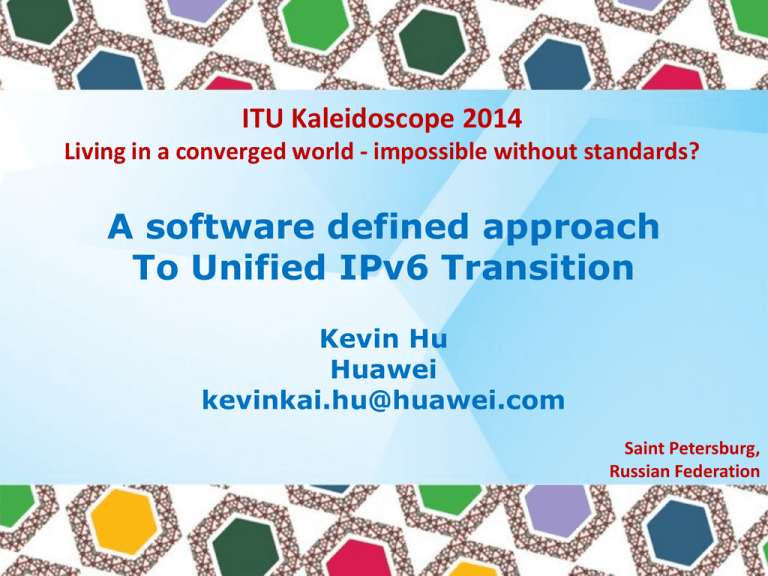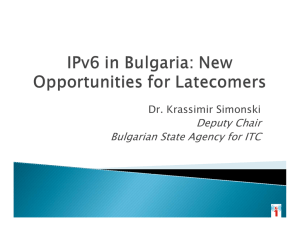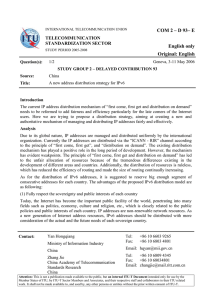A software defined approach To Unified IPv6 Transition ITU Kaleidoscope 2014
advertisement

ITU Kaleidoscope 2014 Living in a converged world - impossible without standards? A software defined approach To Unified IPv6 Transition Kevin Hu Huawei kevinkai.hu@huawei.com Saint Petersburg, Russian Federation Collaborators • China Telecom • Huawei •Qiong Sun •Felix Lu •Chongfeng Xie •Tina Tsou • Telefonica I+D •Diego Lopez (Presenter) • University •Haiyong Xie •Spencer Dawkins •Kevin Hu • Viagenie •Guillaume Leclanche •Wenfeng Xia (Univ. of Sci. & Tech. of China) IPv6: Status Quo and Challenges • Current state of IPv6 transition •Many solutions and multiple scenarios co-exist, e.g. 4-6-4, 66-4, etc. •Slow transition • Challenges •Legacy equipment does not support multiple IPv6 transition technologies at the same time •Lack of native IPv6 applications Lack of motivation and high cost for carriers / service providers / end users to transition to IPv6 Motivation & Rationale • Design a low-cost, unified approach to IPv6 transition •Low-cost: a virtual CPEs(e.g. vRGW) or a SDN enabled CPE can cover different scenarios of IPv6 transition. carriers do NOT have to upgrade/manage CPEs to support a specific IPv6 transition scheme •Unified: the design should be compatible (or accommodate) existing and future IPv6 transition schemes • Users / applications should be able to decide for themselves when and how to start the IPv6 transition SD-IPv6: A Low-Cost, Unified Approach to IPv6 Transition • Leverage the SDN capability to •Decouple network equipment (i.e., data plane) and operating specific IPv6 transition schemes (i.e., control plane) –By leveraging SDN’s separation of control / data plane •Decouple network equipment and implementation of specific IPv6 transition schemes – by leveraging SDN’s NBI to efficiently implement IPv6 apps •Decouple network equipment and deployment of specific IPv6 transition schemes –As a result of the above two enablers SD-IPv6: A Low-Cost, Unified Approach to IPv6 Transition • Leverage the SDN capability to •Decouple network equipment (i.e., data plane) and operating specific IPv6 transition schemes (i.e., control plane) –By leveraging SDN’s separation of control / data plane •Decouple network equipment and implementation of specific IPv6 transition schemes – by leveraging SDN’s NBI to efficiently implement IPv6 apps •Decouple network equipment and deployment of specific IPv6 transition schemes –As a result of the above two enablers SD-IPv6: Architecture • Network equipment is SDN compatible • IPv6 schemes are implemented as SDN apps •SDN apps communicate with SDN controller via NBI SD-IPv6: Data / Control Flow Evaluations I: Lab Experiments • Experiment setup •Use flow generators to generator a varying number of flows •Use commodity hardware • Result •SD-IPv6 can handle a reasonably large number of flows with very high costperformance efficiency Evaluations II: Live Experiments •Provide live Internet access for 270+ participants of ETSI Network Function Virtualization 2nd meeting on April 22–23, 2013 4/22/2013 4/23/2013 250 # Users 200 150 100 50 0 8: 30 AM 9: 30 AM 11 :0 0 AM 12 :0 0 Time PM 1: 30 PM 3: 00 PM 4: 00 PM Deployments I: Santa Clara We have deployed an SDN-IPv6 trial in an enterprise campus in Santa Clara. The following drawing is the network diagram. Deployments II: Shenzhen Applications v4 or v6 host Plug-in v4 or v6 host Access node Controller Provide protocol-independent data model & programmatic interface for new applications/technologies creation v4 or v6 host v4 or v6 host Access node Experiment network region (IPv6 only) v4 or v6 host v4 or v6 host Legacy network region (IPv4 only) Access node Access node v4 or v6 host v4 or v6 host v4 or v6 host SDN -Enabled IPv4 IPv6 Edge device App • IPv6 transition App, called “SDN IPv6” and available for download at http://www.huawei.com/enmobile/app/ and Google Play, and also at Apple Store soon. • Visitors can watch the configuration of SDN-IPv6 deployed in Santa Clara via the App. Administrator can modify the configuration of SDN-IPv6 via the App. Metrics & Tools • Provide live Internet access for 800+ participants of SDN-IPv6 Internet Access for the Global Open Networking and SDN Conference 2013 in Beijing on Aug 29-30, 2013 • The following metrics and tools are summary from this live experiments. SDN IPv6 Deployment Metrics & Tools (1) Monitoring for SDN IPv6 up Time<0.7ms Percentage Flow Set- Flow Set-up Time (ms) 100% 80% 60% 40% 20% 0% 1 Flow Set-up Time 2 3 4 5 6 7 SDN IPv6 Deployment Metrics & Tools (2) 90% 80% <-->border router) Percentage RTT < 4ms (host 100% 70% 60% 50% 40% 30% 20% 10% 0% 1 Packet Latency in Data Plane 2 3 4 5 Percentage RTT<4ms 6 7 8 SDN IPv6 Deployment Metrics & Tools (3) Flow Injection Rate CPU Usage SDN IPv6 Deployment Metrics & Tools (4) Active Flow Total Traffic Volume Programmable Networks on Demand Dynamically create, enable, and disable services without changes to physical infrastructure. IPv6 Based Services Layer Programming logic resides here. Nurtures development of native applications. Simplifies IPv6 transition from existing complex mechanism. Network Resource Abstraction Layer OpenV6 Platform Resource based approach opens the network. Policies applied to specific networks. Network Elements Layer Summary • We provide a software defined approach to IPv6 transition •Low cost •High performance •Unifying existing IPv6 schemes •Extensible: easy to add / implement new IPv6 schemes •Easy to implement, deploy and operate For more details, please refer to our ACM SIGCOMM 2013 poster titled “A Software Defined Approach to Unified IPv6 Transition”. Questions



